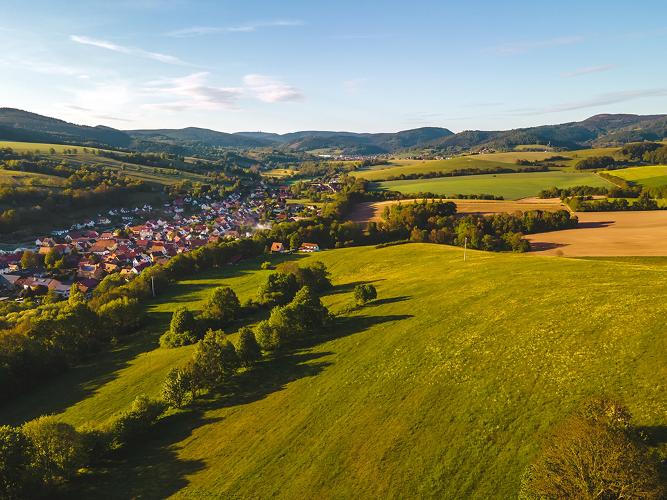The Labour Party's recently announced "Grey Belt" housing policy has sparked passionate debate. Whilst we, like many architects and planning professionals, acknowledge the need to increase housing supply, it's clear that we must be incredibly cautious when it comes to building on any Green Belt land. But we also wonder if “grey-belt development” is an opportunity to create developments with enhanced environmental credentials?
The Labour statement includes the following details:
“The current planning system isn't working. The Tories allow developers a free-for-all on the best quality land, with development that is haphazard and unplanned, and often leads to local opposition.
“Labour will not build on genuine nature spots and will set tough conditions for releasing green belt land for house building so that building more homes and protecting nature go hand-in-hand.
“The term ‘Grey Belt' refers to neglected areas such as poor-quality wastelands and disused car parks that are in the Green Belt. These are places that we could build one, whilst we improve and protect genuine nature spots”.
YOU CAN READ THE FULL LABOUR PARTY DEVELOPMENT STATEMENT HERE
Embracing the Grey Belt
Firstly, we believe there's merit in Labour's distinction between pristine Green Belt spaces and neglected, low-quality areas within the Green Belt. These so-called ‘Grey Belt' sites, such as the derelict car parks or overgrown wasteland Labour highlight, could accommodate new housing developments. However, once this “green” or “grey” land has been built on with housing – it will no longer be “green”, and cannot be considered a protected, ecological space. So one must ask –could the land be better used from something else, more “green” that would preserve its ecological credentials? Or – could special criteria be applied to so-called “grey-belt” developments – enhanced environmental or ecological performance, or open space and public realm targets perhaps, that would ensure the quality of the environment and its integration with the surrounding green habitats?
Prioritising Quality Over Quantity
We think architects and planners will play a key role in ensuring that the Labour policy leads to sensitive development which is appropriate for the green-belt environment. Skilled professionals need to be at the forefront of creating new policy, ensuring any development on “Grey-Belt” prioritises:
Biodiversity and Landscaping: New housing can't come at the expense of existing ecosystems. New developments should have specifically enhanced criteria that respect the privileged green belt location, so they integrate with the surrounding ecological and natural habitat. A clear approach to biodiversity and biophilia is crucial. We need developments that integrate with and enhance the surrounding environment to high standards.
Urban Design and Public Space: Thoughtful design that develops communities and enhances neighbourhoods in the green belt is essential. Both wild and manicured green landscaped spaces, play areas, open landscaping with high levels of biodiversity, community spaces, plentiful cycle lanes, and pedestrian access must be incorporated to create green and ecologically positive spaces.
Environmentally responsible design: All building proposals in the green belt should recognise the special nature of the location and promote green, sustainable materials and energy consumption – exceeding building regulations and achieving net zero. Pollutants and non-recyclables are a big no-no!
Brownfield First
Before touching the Grey Belt, we should also agree that a policy of "Brown Field first" is best. Many, many urban locations still incorporate underutilised industrial or commercial land: so-called “Brown Field” sites. These can be former factories, offices or warehouses– that are perfect for redevelopment – and they still litter all our cities nationwide. These offer the best opportunities to create new housing using the existing infrastructure and without eroding greenbelt land.
The Key Role of Architects
Architects play a crucial role in making Brown Field development attractive to landowners. By creating innovative, often mixed-use proposals that integrate within the existing urban environment, or imagining creative concepts for new residential or commercial development, integrated into the local townscape context, we can support sensitive Brown Field development that repairs broken urban infrastructure and reshapes towns and cities.

Our Green Belt. A Last Resort
The Green Belt serves a vital purpose – and once it's gone, it's lost forever. For this reason, we agree that re-use of “Grey Belt” sites is the best way forward but a key issue will be by who and how sites are selected. i.e. which land is “grey” and which areas should remain “green”, The selection of the sites should be properly managed and publically accountable with policy-driven criteria. These should include:
Minimal ecological impact: Sites with minimal existing flora and fauna prioritised – criteria should be developed to assess the level of existing bio-diversity and to establish the current contribution to the local ecology, in order to prioritise sites with low or no bio-diversity or ecology.
Contamination levels: Brownfield contamination can be expensive to remedy. Grey belt sites may require less or minimal intervention, making them more attractive for development.
Accessibility to existing infrastructure: If sites have easy access to existing public transport, schools, and amenities - communities' development can be better placed and require less disruption.
A Sustainable Future for Housing
The housing crisis in the UK requires innovative solutions. But these solutions must be both environmentally and socially sustainable. By focusing on Brown Field development first, then prioritising high-quality design on appropriate Grey Belt land, chosen with a clear selection criterion, it is likely the housing supply can be increased to be closer to where it needs to be without sacrificing our vital green spaces.
This is where collaboration between architects, government, and landowners is key. And, working together we can build a future with well-designed, ecologically sustainable housing for everyone without sacrificing our crucial green space.

